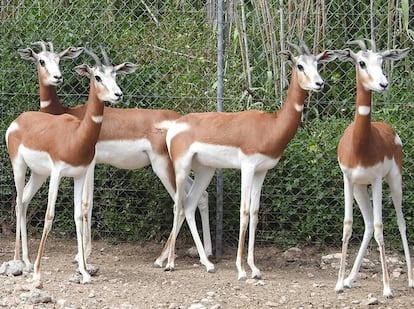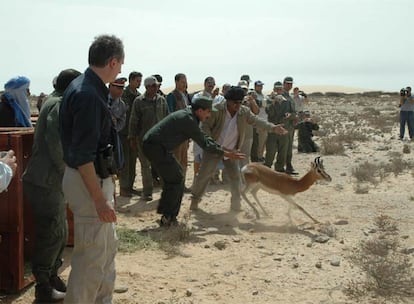The Saharan gazelle saved from extinction in southern Spain
A group of mhorr was given refuge in Almería half a century ago, with the aim of saving them from extinction. Now a breeding program means they are thriving back in the Sahara

Half a century ago in Nouadhibou, Mauritania, key Saharan species including the red-necked ostrich, oryx, addax and mhorr desert gazelles were on the point of extinction. With the animals caught up in conflict and indiscriminately hunted by railroad workers in the West African country, few conservationists believed they would survive.
José Antonio Valverde, a Spanish army captain and photographer who also dedicated his time to the conservation of the Andalusian national park of Doñana, learned that the mhorr, also known as Dama gazelles, were close to disappearing forever. These antelopes could reach speeds of up to 75 kilometers per hour on land, but were not fast enough to evade the guns of poachers.
Valverde had already undertaken research trips across Africa, but it was the elegance of the Dama gazelle that stole his heart when he saw them in the wild in 1970. He set into motion a rescue operation to take the last remaining Dama gazelles to the Doñana park in Spain. Their demise was imminent and there was no time to devise a long-term operation. The biologist learned that a Spanish soldier stationed in Western Sahara was sheltering a group of dama gazelles, so promptly negotiated their transfer to Spain and the creation of a refuge.

Half a century later, their descendants and those of two other gazelle species (dorcas and Cuvier’s) now number 4,000 and have been reintroduced in Tunisia, Morocco and Senegal. But as conservationists are finding, inbreeding has posed a challenge to their long-term survival.
Manuel Mendizábal offered his facilities at the University of Almería, a region of Spain where the climate is similar to the desert environment the animals are used to. He was joined by the naturalist, journalist and photographer Antonio Cano, a friend of Valverde’s who started what is now the Saharan Fauna Rescue Center. The Almería provincial government covered the maintenance costs, and the army provided the group with a Douglas DC-4 aircraft to transport the gazelles. In 1971, the first gazelles arrived, increasing to 19 specimens over four years.
The rescue mission soon morphed into a captive-breeding program to ensure the survival of the species, and to allow the eventual reintroduction of the animals to the place where they belong. The researcher Mar Cano, the daughter of the photographer (who died in 2015), expanded the project to other endangered species — gazelles such as dorcas (Gazella dorcas neglecta), Cuvier’s gazelles (Gazella cuvieri), and mouflon (a kind of sheep; Ammotragus lervia sahariensis).
The plan was successful, and 14 years later the first offspring from captive breeding in Almería were reintroduced into the Sahara. Teresa Abáigar, a researcher at the Experimental Station of Arid Zones of Almeria at the university, affirmed that 50 years on, “the programs have managed to save the species from extinction.”
But the plan still faces difficulties and threats. The first is to ensure that specimens bred in captivity and without predators can survive in the environment that was once theirs. In this sense, Abáigar explained, “we try to intervene as little as possible and when a reintroduction is carried out, we encourage a progressive adaptation to different types of food, to another space and to social organization that depends on them and not on us.”
It is also a challenge for the gazelles to learn to identify their predators after years of living in a harmless environment, she added. So far, they have been reintroduced mainly in protected reserves, but this has not prevented some encounters with jackals. Their biggest predators are still human beings: “The main problem is poaching.” Another difficulty is limited space. The 20-hectare Almería farm currently hosts about 400 animals and, according to Abáigar, “is practically at the limit of its capacity”. Added to this are the difficulties inherent to breeding, such as disease prevention.
The fundamental challenge from the outset was to recover the species numbers from such a small pool, which condemned the herd to inbreeding. However, research by Eulalia Moreno, from the Spanish National Research Council, in collaboration with Aurora García-Dorado of the Complutense University of Madrid and Eugenio López-Cortegano, from the University of Edinburgh, have found that careful management of this limitation has become an advantage by “favoring natural selection to maintain good juvenile survival in Cuvier’s and mhorr gazelles”.

Although smaller populations are always expected to show lower fitness and adaptive potential, experience at the Almeíra center has shown that these limitations can be minimized “by allowing some level of random mating and natural selection or by performing reintroductions into the wild as early as possible,” according to the research published in Heredity, a scientific journal in the Nature group.
Captive-breeding programs for endangered species start with a very small population size in the vast majority of cases. Not infrequently, this means fewer than 10 individuals, as is the case of three of the four species at the Almería center, according to the Spanish National Research Council. Under these conditions, the main concern of the managers of such programs is to minimize the loss of genetic diversity of the population and avoid inbreeding, which normally makes individuals more vulnerable. According to Moreno, inbreeding management “has favored the purging of some detrimental genetic variants, which has contributed to maintaining good survival of the offspring of these two species [mhorr and Cuvier’s gazelles] and, probably, to allow the prevalence of their populations.”
In this sense, the researcher explained, the main goal “should always be to increase the size of the population as much as possible while maintaining the greatest genetic variability, but we must also give the opportunity for natural selection to act to a greater or lesser degree,” she said. “We must take into account that the systematic choice of breeding pairs with minimal kinship reduces the chances of purging by natural selection of many harmful variants”. The results of the work also show that the elimination of detrimental variants in populations should occur slowly and progressively, to avoid the collapse that would result from a rapid and high increase in inbreeding.
Tu suscripción se está usando en otro dispositivo
¿Quieres añadir otro usuario a tu suscripción?
Si continúas leyendo en este dispositivo, no se podrá leer en el otro.
FlechaTu suscripción se está usando en otro dispositivo y solo puedes acceder a EL PAÍS desde un dispositivo a la vez.
Si quieres compartir tu cuenta, cambia tu suscripción a la modalidad Premium, así podrás añadir otro usuario. Cada uno accederá con su propia cuenta de email, lo que os permitirá personalizar vuestra experiencia en EL PAÍS.
¿Tienes una suscripción de empresa? Accede aquí para contratar más cuentas.
En el caso de no saber quién está usando tu cuenta, te recomendamos cambiar tu contraseña aquí.
Si decides continuar compartiendo tu cuenta, este mensaje se mostrará en tu dispositivo y en el de la otra persona que está usando tu cuenta de forma indefinida, afectando a tu experiencia de lectura. Puedes consultar aquí los términos y condiciones de la suscripción digital.
Archived In
Últimas noticias
Chris Martin, Taylor Swift, Elijah Wood and other famous wedding ‘crashers’
‘How does it feel to be a failure?’: Elizabeth Berkley’s journey from ‘Showgirls’ ridicule to vindication
The story of the Málaga virus: The code that haunted Google’s cybersecurity center director for 30 years
The impact of Ecuador’s mega-prison: A polluted river, cleared forests and military checkpoints
Most viewed
- Christian Louboutin: ‘Young people don’t want to be like their parents. And if their parents wear sneakers, they’re going to look for something else’
- The low-cost creative revolution: How technology is making art accessible to everyone
- Liset Menéndez de la Prida, neuroscientist: ‘It’s not normal to constantly seek pleasure; it’s important to be bored, to be calm’
- All the effects of gentrification in one corner of Mexico’s Colonia Roma
- December Social Security and SSI payments: Dates, double checks and the 2026 COLA increase









































